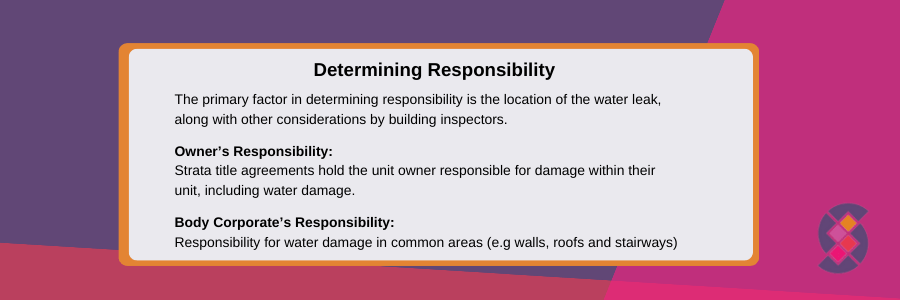Strata Property Water Damage – Who is Responsible?
With an estimated one in six Australians living in strata properties, disputes over property damage and repairs are common — especially when it comes to water damage. Due to the proximity of shared living spaces and connected plumbing systems, determining who is ultimately responsible for water damage can be confusing.
In this article, we’ll provide clarity on identifying the responsible strata parties for shouldering the repair costs of water-related property damage, as well as the options for dealing with water leaks in strata buildings.
Common Causes of Water Leaks
The potential for water leaks is compounded in strata properties due to the interlinked piping system that runs throughout the building, often across multiple units. Because of this, bad practices by owners in one unit can result in a run-off effect on the piping of other units.
Water leaks can be caused by both internal and external factors. Internal factors include plumbing issues such as faulty fixtures and appliances, worn pipes, and loose connections, as well as blocked drains due to improper disposal of materials.
External causes of water leaks typically result from roofing issues and structural damage. Accidental runoff from balconies into cracked tiles and faulty sealant joints can allow water to seep into the building, resulting in water damage to the property.
Determining Who is Responsible for Water Damage
So, who is responsible for the cost of repairs from water damage? Considering that each case of water damage is unique, there is no sure-fire way to determine the responsible party without first understanding the source of the damage.
In general, the location of the cause of the water leak plays the biggest role in determining the responsible party, but there are also other considerations to take into account.

Instances where the owner is responsible
Any damage to the property that is sustained is the responsibility of the owner of the source of the leak. So if a leak occurs from a pipe that services just one apartment (e.g. a branch pipe) then the damage caused will be the responsibility of the individual lot owner of that pipe.
Sometimes the origin of the water leak comes from outside the unit. For example, a burst water pipe in the bathroom of a unit could potentially cause water to seep into the floor, causing a water leak that impacts the integrity of the ceiling of the unit below. In such cases, it may be apparent that the fault lies with the unit below at first glance. Only upon closer inspection will the source of the water leak be discovered to be from the upper unit.
Instances where the body corporate is responsible
Situations where the body corporate is responsible for dealing with water damage are much clearer. Any water damage caused from common property structures (roofs, shared piping e.g. trunk pipes) are the responsibility of the strata body corporate.
Is Water Damage Covered by Strata Insurance?
Strata insurance does provide limited coverage for water damage.
What’s covered: Accidental mishaps like burst pipes or leaking faucets usually fall under the strata insurance coverage, provided that claims are immediately filed upon noticing the damage. Not responding immediately to these problems may result in more serious water leaks developing over time, which are not covered.
What’s not covered: Poor maintenance and gradual wear and tear of piping or plumbing. Older strata buildings are generally more prone to such issues due to building age, which is why proper and regular maintenance should be conducted by the strata body corporate to prevent water leaks from developing unnoticed. Unit owners should similarly exercise care in how they use water fixtures and appliances to avoid causing issues in the piping that may result in costly repair expenses.
Insurance will only cover ‘resultant damage’ but will not cover the cause of the leak. For example with a burst pipe, insurance will cover the damage caused to ceilings/floors etc, but will not cover the repair of the pipe. Also remember that there is usually an excess to pay.

Preventing Water Damage in Strata Properties
As mentioned earlier, water damage often stays hidden until it’s too late. Owners should keep a lookout for common signs of water leaks and damage, such as
- Damp patches on walls
- Mould on surfaces
- Dripping from ceilings or piping
- Bloated wall or floor surfaces
Remember that early detection and prompt action are the best defence against serious water damage. Regularly inspecting potential trouble spots and notifying the relevant strata committee or maintenance staff can help minimise the occurrence of water leaks in both common areas and units.
Keep Your Strata Property Free from Water Damage
We hope that the guide above has provided you with sufficient context about party responsibility, insurance coverage, and the proactive measures to take against water leaks. Still, water leaks can happen unexpectedly and result in inconvenience for all strata members.
If you are looking for reliable support in managing water damage and repairs, Strata Data offers comprehensive strata management services in Adelaide that cover repairs and maintenance when water leaks happen. Our team of strata managers can ensure that all issues relating to a strata property are seamlessly and effectively managed.
Please note: The legislation on holding insurance, and which entity is responsible for holding said insurance can vary. This article is a guide to this area of insurance only. Any advice in this article is general advice only and has been prepared without taking into account your objectives, financial situation or needs. Before making a decision to acquire any product(s) or to continue to hold any product we recommend that you consider whether it is appropriate for your circumstances.



